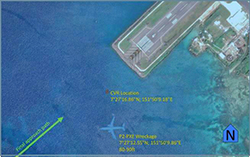FSM Investigator in Charge releases preliminary report on crash of Air Niugini flight PX 073
- Details
- Category: News
- Published: Sunday, 23 December 2018 23:39
- Written by Bill Jaynes
- Hits: 1828
By Bill Jaynes
The Kaselehlie Press
October 26, 2018
 Federated States of Micronesia—The FSM Department of Transportation, Communications, and Infrastructure (DTC&I) has released its preliminary report on the crash into the lagoon of Air Niugini Flight PX 073. The report represents no more than a statement of facts as they are known at this time with no analysis or conclusions drawn.
Federated States of Micronesia—The FSM Department of Transportation, Communications, and Infrastructure (DTC&I) has released its preliminary report on the crash into the lagoon of Air Niugini Flight PX 073. The report represents no more than a statement of facts as they are known at this time with no analysis or conclusions drawn.
FSM Investigator in Charge, Master Halbert says that a conclusive report will be issued one year from the date of the crash.
The preliminary report lists the agencies that have been involved in the investigation including investigators from the Papua New Guinea Accident Investigation Commission, the US National Transportation Safety Board, the Federal Aviation Administration, and Boeing. Technical advisers from the US National Weather Service are assisting the US Accredited Representative.
The DTC&I is responsible for the “no-blame” safety investigation. The preliminary report is based on the investigation carried out by DTC&I at the date of its publication. It contains factual information, and safety actions taken and proposed.
The report discusses the factual history of the flight.
“On Friday 28 September 2018, a Boeing 737-8BK aircraft, registered P2-PXE, was being operated by Air Niugini Limited, on a scheduled passenger flight from Pohnpei to Chuuk, Federated States of Micronesia.
“At 23:45 UTC1 (09:45 local time) the aircraft impacted the water of Chuuk Lagoon about 1,500 ft (460 m) short of the runway 04 threshold, during its approach to runway 04 at Chuuk International Airport. As the aircraft settled in the water, it turned clockwise through 210 degrees and drifted 460 ft (140 m) south east of the runway 04 extended centreline, with the nose of the aircraft pointing about 265 deg.
“There were 12 crew members and 35 passengers on board. Six passengers were seriously injured, and one passenger was fatally injured.
“The 12 crew members and 34 passengers exited the aircraft and were promptly rescued and brought to shore by U.S. Navy divers (who were the first on scene), Chuuk State Government boats, Red Cross, Transco, and more than twenty privately-owned boats. Local divers located the fatally injured passenger in the aircraft 3 days after the accident.”
The report lists one fatal injury, six serious injuries, and the rest as minor or nil among the 47 souls who were aboard the plane. It provided a diagram showing where each passenger was assigned to have been seated and what classification of injuries they sustained.
The report says only that the rear fuselage behind the wing had fractured during the impact sequence. It draws no conclusions as to whether or not the fracture of the fuselage may have contributed to the severity of the injuries of the passengers who upon personal observation, were seated very near where I observed that a hole had opened up in the side of the plane.
The report lists the pilot in command as a male from Papua New Guinea who was 52 years old. That pilot had accrued 19,780.7 hours of flight time, 4,987 of those in command and 2,276.4 hours of those command hours on a Boeing 737. During the 30 day prior to the crash into the lagoon he had flown 44.3 hours, 18.5 of those hours during the seven days previous. He had 10.3 hours off prior to the flight on September 28 and was operating on approximately 5 and a half hours of sleep before the flight.
The copilot was a male from Australia who was 35 years old. He had a total flying time of 4618 hours, 1820 of them in command. 368 of those hours were at the controls of a Boeing 737. He was operating on approximately 6.6 hours of sleep from the night before.
The report also listed statistics regarding the age, equipment and airworthiness rating of the Boeing 737-8BK.
The report said that “the Chuuk Terminal Aerodrome Forecast that was in effect at 22:00 on 27 September was as follows:
Wind 100 degrees at 14 knots with gusts up to 25 knots. The visibility was 5 statute miles. Showers of rain to be expected with cloud scattered at 800 feet and overcast at 5000 feet.”
As the plane approached Chuuk it provided the following conditions the flight would experience. “Wind direction variable at 5 knots, visibility 14 statute miles, scattered cumulonimbus cloud at 1,200 feet, broken cloud at 12,000 feet, overcast at 28,000 feet, temperature 26 degrees C, dewpoint 25, altimeter setting for QNH2 2973.”
The flight data recorder was on its rack within the aircraft and was recovered by local divers. The cockpit voice recorder was recovered from the seabed by US Navy divers about 440 feet back along the flight path, in the area ahead of the first point of water impact.
“The initial examination of video taken by the divers showed that the main landing gear separated from the aircraft during the water impact. The rear fuselage behind the wing had fractured during the impact sequence.
“The aircraft sank in 90 feet of water to the Chuuk Lagoon seabed.”
“The areas of organizational and management information which may have directly or indirectly influenced the operation of the aircraft is the subject of the ongoing investigation. The organizational and management investigation may include, but not be limited to, the aircraft operator; the air traffic services; aerodrome and weather service agencies.”
“The investigation is continuing and will include, but will not be limited to, further examination and analysis of aircraft, crew, recorded data, aircraft operator, management and organization data, weather and airport facilities.”
Section two of the report entitled “Analysis” is reserved for the final report that will be issued by 11 months from today.
Section three, entitled “Conclusions” with subheads, “Findings” and “Causes and Contributing Factors” are also reserved for the Final Report.
It is not the FSM’s role in the investigation to provide a definitive answer as to who, or what was the cause of the accident.
The report said that as a result of the accident “Chuuk and Pohnpei Airport categories have been changed from CAT B to CAT X (CAT X being more restrictive) operations by Air Niugini Limited.
“Other similar airports in the Air Niugini Boeing network are being reviewed and may be re-categorized accordingly.”
The report did not define what the differences are between those categories, only that the safety action proposed would be that the Category X training requirements for Flight Crew should be initiated.
A copy of the full report can be found at:
https://www.dropbox.com/s/ vihiizmlmy5idxl/P2-PXE%20 TC%26I%2018-1004%20Prelim%20 Report.pdf?dl=0






